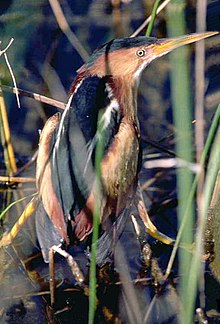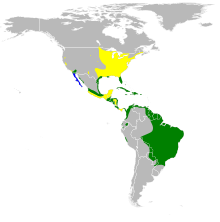Least bittern
| Least bittern | |
|---|---|
 |
|
| Scientific classification | |
| Kingdom: | Animalia |
| Phylum: | Chordata |
| Class: | Aves |
| Order: | Pelecaniformes |
| Family: | Ardeidae |
| Genus: | Ixobrychus |
| Species: | I. exilis |
| Binomial name | |
|
Ixobrychus exilis (Gmelin, 1789) |
|
| Subspecies | |
|
|
 |
|
| Range of I. exilis Breeding range Year-round range Wintering range | |
| Synonyms | |
|
Ardetta exilis |
|
Ardetta exilis
Ardetta neoxena
Ixobrychus exilis neoxenus
Ixobrychus neoxenus
The least bittern (Ixobrychus exilis) is a small heron, the smallest member of the family Ardeidae found in the Americas.
The least bittern is one of the smallest herons in the world, with perhaps only the dwarf bittern and the black-backed bittern averaging smaller in length. This tiny bittern can measure from 28 to 36 cm (11 to 14 in) in length, and the wingspan ranges from 41 to 46 cm (16 to 18 in). Body mass is from 51 to 102 g (1.8 to 3.6 oz), with most birds between 73 and 95 g (2.6 and 3.4 oz), making this perhaps the lightest of all herons. Yet, a recent manual of avian body masses, cites yet another species in this genus, the stripe-backed bittern, has having a mean body mass slightly lower than the least bittern, which is credited with a mean mass of 86.3 g (3.04 oz). This bird's underparts and throat are white with light brown streaks. Its face and the sides of the neck are light brown; it has yellow eyes and a yellow bill. The adult male is glossy greenish black on the back and crown; the adult female is glossy brown on these parts. They show light brown parts on the wings in flight.
The least bittern is an elusive bird. They spend much time straddling reeds. When alarmed, the least bittern freezes in place with its bill pointing up, turns its front and both eyes toward the source of alarm, and sometimes sways to resemble wind-blown marsh vegetation. This is perhaps a predator-avoidance behaviour, since its small size makes the bittern vulnerable to many potential predators. Thanks to its habit of perching among the reeds, the least bittern can feed from the surface of water that would be too deep for the wading strategy of other herons. The least bittern and much larger and different-looking American bittern often occupy the same wetlands, but may have relatively little interaction because of differences in foraging habits, preferred prey, and timing of breeding cycles. The least bittern arrives on its breeding grounds about a month after the American bittern, and leaves one or two months earlier. John James Audubon noted that a young captive least bittern was able to walk with ease between two books standing 4 cm (1.6 in) apart. When dead, the bird's body measured 5.7 cm (2.2 in) across, indicating that it could compress its breadth to an extraordinary degree.
...
Wikipedia

